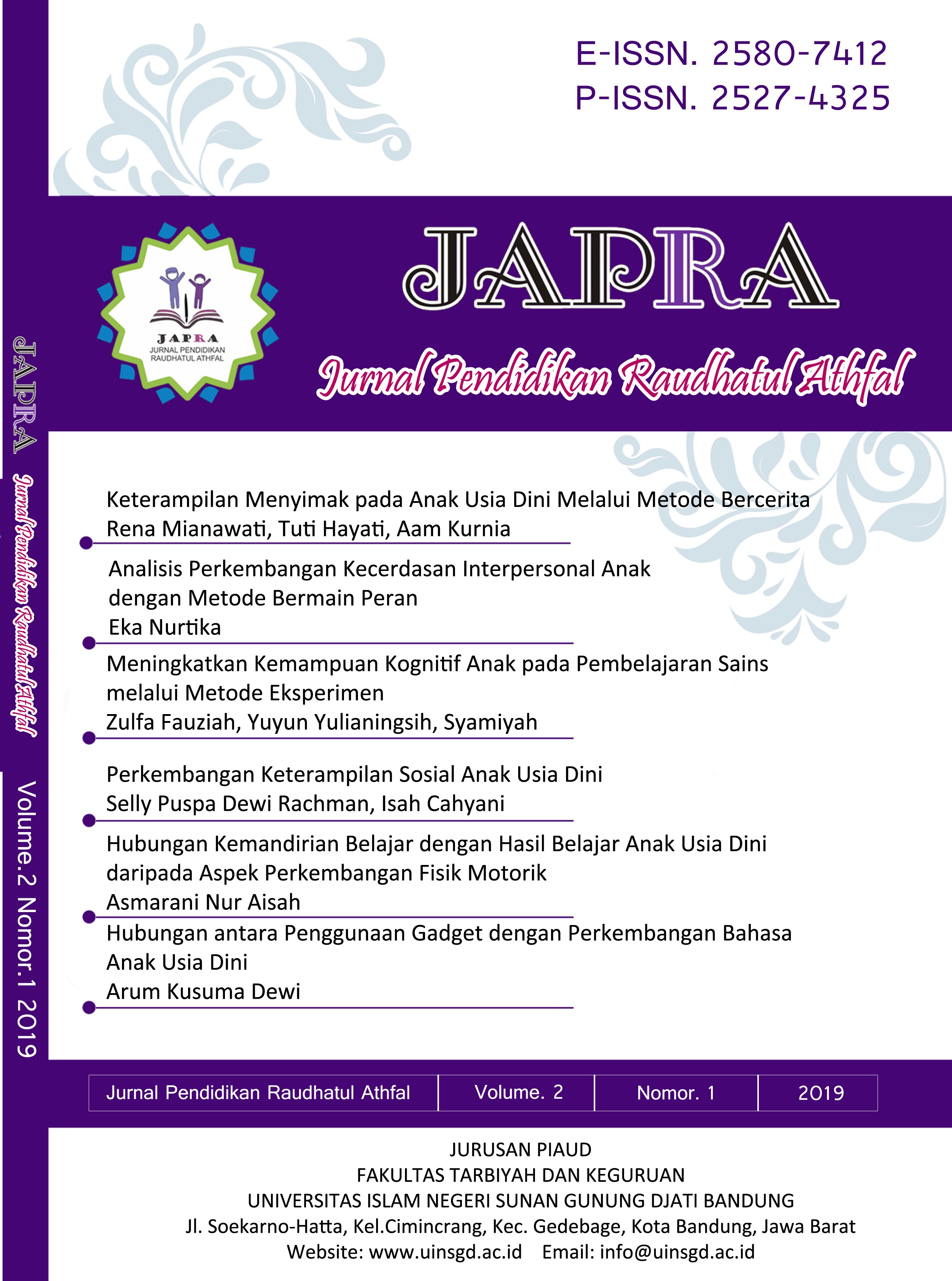Upaya Meningkatkan Karakter Disiplin Anak Melalui Pohon Kedisiplinan di Tk IK Keluarga Ceria Sleman
DOI:
https://doi.org/10.15575/japra.v3i1.8104Keywords:
Anak, Disiplin, Karakter, Kualitatif, Pendidikan, Children, Discipline, Character, Qualitative, EducationAbstract
The background of the problem in this study is that the behavior of the discipline is not fully owned by the children, so that it affects the teaching and learning process in the classroom. There needs to be a renewal in the form of strategies or media that can familiarize the discipline behavior of children, so that children can get used to discipline by using the discipline tree. This study aims to determine the application of the "Disciplinary Tree" in improving the character of child discipline and to measure the increase in the character of child discipline through "Disciplinary Trees in Kindergarten IK Ceria Family Sleman. The research method used is a research method with a qualitative approach in the form of classroom action research (CAR). Data collection is done by observation, interviews, and documentation. The subjects in this study were children of Class B1 Kindergarten IK IK Ceria Sleman Family with a total of 22 students, consisting of 9 girls and 13 boys. The results of this study can be concluded that: 1) the application of the discipline tree is done by introducing the discipline tree, its function and how to use it in children, then the children are asked to try and apply it during the learning activities. The teacher observes the child's disciplined attitude when using the discipline tree; 2) increasing the character of child discipline through Disciplinary Trees at IK IK Ceria Happy Family by 39.7%References
‘Ulwan, Abdullah Nashih, Pendidikan Anak Dalam Islam, Solo : Insan Kamil, 2015
Arismantoro, Tinjauan Berbagai Aspek Character Building, Yogyakarta: Tiara Wacana, 2008
Departemen Pendidikan Nasional, Kamus Bahasa Indonesia, Jakarta: Pusat Bahasa, 2008
El-Khuluqo, Ihsana, Manajemen PAUD (Pendidikan Anak Usia Dini): Pendidikan Taman Kehidupan Anak, Yogyakarta: Pustaka Pelajar, 2015
Gupte, Suraj, Panduan Perawatan Anak, Jakarta : Pustaka Populer Obor, 2014
Hasanah, Hetti Nurjami’atun, “Peningkatan Kemampuan Sains Anak Usia Dini Melalui Metode Eksperimen (Tanaman Rimpang) Di Kelompok Bermain Islam Kreatif Keluarga Ceria Beran Tridadi Slemanâ€,Skripsi, Program studi Pendidikan Islam Anak Usia Dini (PIAUD) STPI Bina Insan Mulia Yogyakarta, 2017
John, Eltin, “Upaya Meningkatkan Kedisiplinan Anak di Kelas melalui Ceritaâ€, Jurnal Pendidikan Penabur, No.16/Tahun ke-1,. Jakarta : BPK Penabur, 2011
Listyarti, Retno, Pendidikan Karekter dlam Metode Aktif, Inovatif, & kreatif, Jakarta : Erlangga, 2012
Majid, Abdul, Pendidikan Karakter Prespektif Islam, Bandung: Rosdakarya, 2012
Maksudin, Pendidikan Karakter Nondikotomik, Yogyakarta: Pustaka Pelajar, 2013
Ma'sumah, Siti,“Pengaruh Disiplin Belajar Terhadap Prestasi Siswa Kelas IVâ€,Skripsi. Universitas Negri Semarang, 2015
Moleong, Lexy J, Metodologi Penelitian Kualitatif, Bandung: Rosda, 2012
Mudlofir, Ali, “Pendidikan Karakter :Konsep Aktualisasinya dalam Pendidikan Islamâ€. Jurnal Pendidikan Islam, Vol. 7 Nomor 2. Surabaya : Nadwa | IAIN Walisongo, 2013
Mufidah, Umri, “Efektivitas Pemberian reward melalui metode token ekonomi untuk meningkatkan kedisiplinan anak usia diniâ€, Indonesian Journal of Early ChildhoodEducation Studies, No.1, Vol.2. FIP UNNES, 2012
Musbikin, Imam, Mengapa ya Anakku Kok Suka Berbohong? Yogyakarta: Diva Press, 2009
Mushoffa, Aziz, Aku Anak Hebat Bukan Anak Nakal, Yogyakarta: Diva Press, 2009
Naim, Ngainun, Character Building,Yogyakarta :Ar-Ruzz Media, 2012
Purwanto, Setyoadi, Pendidikan Karakter melalui Seni, Yogyakarta: Pustaka Pelajar, 2016
Rahayuningsih, Dwi Puji, “Peningkatan Kemampuan Disiplin Pada Anak Usia Dini Melalui Kegiatan Bermain Peran di RA Muslimat NU Mafatihul Islamiyah†Jurnal Ilmiah, No. 1, Vol 1. PG-PAUD IKIP Veteran, 2012
Rimm, Silvia, Raising Preschoolers Parenting For Today, Jakarta: Gramedia Pustaka, 2003
Sudewo, Erie, Character Building, Jakarta: Republika, 2011
Sudijono, Anas, Pengantar Evaluasi Pendidikan, Bandung: Raja Grafindo, 2011
Sugiyono, Metode Penelitian Pendidikan, Bandung: Alfabeta, 2014
Suyadi, MaulidyaUlfa, KonsepDasar PAUD, Bandung :Rosdakarya, 2013
Suyadi, Penelitian Tindakan Kelas (PTK) dan Penelitian Tindakan Sekolah (PTS), Yogyakarta: ANDI OFFSET, 2012
_______,Teori Pembelajaran Anak Usia Dini Dalam Kajian Neurosains, Bandung : Rosdakarya, 2014
Tum, “Meningkatkan Kedisiplinana anak melalui metode pemberian tugas pada kelompok B di TK Bungamputiâ€, Skripsi, Program Studi PGPAUD, Jurusan Ilmu Pendidikan, Fakultas Ilmu Keguruan dan Ilmu Pendidikan Universitas Tadulako, 2013.
Umayanti, Khikmah, “Upaya Meningkatkan Kreativitas AUD melalui Media Tangramâ€, Skripsi,Program Studi Pendidikan Guru Raudhotul AtfalSTPI Bina Insan Mulia Yogyakarta, 2016
Widowati, Nurcahyani Desi, “Hubungan antara pola asuh orang tua, motivasi belajar, kedewasaan dan kedisiplinan siswa dengan prestasi belajar sosiologi siswa kelas XI SMA Negeri 1 sidoharjo wonogiri†Jurnal Ilmiah Pendidikan Sosial, Vol 3, No. 2, Surakarta : FKIP.UNS, 2013
Zubaedi, Desain Pendidikan Karakter : Konsepsi dan aplikasinya dalam lembaga pendidikan. Jakarta: Kencana, 2011
Downloads
Published
Issue
Section
License
Authors who publish with this journal agree to the following terms:
- Authors retain copyright and grant the journal right of first publication with the work simultaneously licensed under a Attribution-ShareAlike 4.0 International (CC BY-SA 4.0) License that allows others to share the work with an acknowledgment of the work's authorship and initial publication in this journal.
- Authors are able to enter into separate, additional contractual arrangements for the non-exclusive distribution of the journal's published version of the work (e.g., post it to an institutional repository or publish it in a book), with an acknowledgment of its initial publication in this journal.
- Authors are permitted and encouraged to post their work online (e.g., in institutional repositories or on their website) prior to and during the submission process, as it can lead to productive exchanges, as well as earlier and greater citation of published work (See The Effect of Open Access).
